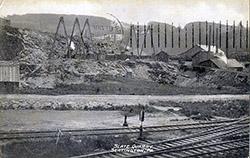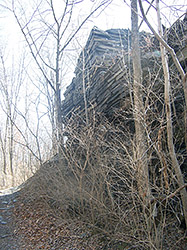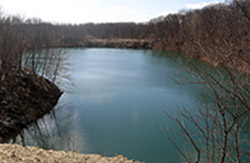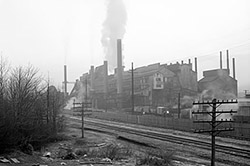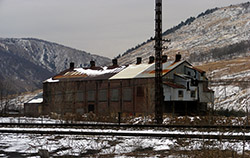![]()
Just a hundred years ago, the landscape of the United States was much different. Then, the country was in the midst of a sweeping industrial development that would make the United States the most industrialized country in the world. The United States was filled with industrial plants, factories and mines; they were everywhere. For example, the immediate area around my hometown of Slatington in eastern Pennsylvania was filled with slate quarries. There were dozens of quarries producing slate for roofs and for school blackboards. The town also had an iron works, textile or sewing mills, a gas works, brewery, umbrella factory and more. (The images are clickable for a larger size.)
Photo credit C.T. Evans
If you were to walk the area around Slatington today, as I have done, you will find little that remains of the town's once thriving industrial past--You've got to be careful when you take such a walk because much of the land is private property and some of it is actually a little on the dangerous side. What remains, besides the piles of discarded waste slate, are some piled slate where the cranes and buildings once stood. All of the buildings--most of which were rather ramshackle wooden structures--have disappeared. You might find some cable moorings left in the ground where the derrick structures were anchored, but that is about it. There are also big holes in the ground that are now filled with water. These were the quarries of a century ago from where the slate was blasted out. These quarries and mounds of slate are the ruins of this country's industrial age.
Photo credit C.T. Evans
If we move north three miles up the road from from Slatington to Palmerton, then we can see another example of the crumbling of the once mighty industrial infrastructure of the United States. Now there is very little left of the former New Jersey Zinc factory west plant in Palmerton; the east plant, in the same town, is still working.
Photo credit Library of Congress
At its height, the zinc factory employed thousands and thousands of men and women--in fact, you might call Palmerton a typical factory town as it was named after the president of the Zinc factory, Stephen Palmer. While Slatington was a "slate" town; Palmerton was a "zinc" town; and Bethlehem, home to Bethlehem Steel, was a "steel," etc. Early in the twentieth century, the zinc company located its smelting operation in Palmerton to take advantage of the easy availability of coal from eastern Pennsylvania and zinc ore from northern New Jersey. The zinc factory went right on working through the Great Depression, World War II and the Cold War. My grandfather, uncles and cousins all worked there at different times. Now large parts of the west plant, which once spanned over thirty buildings on some two hundred acres, are crumbling, and actually not all that much really remains except a building or two and some heaps of slag. (2024 update, it's all gone.)
Photo credit road_less_trvled
The Palmerton Zinc Company site became a Superfund cleanup site, monitored by the Environmental Protection Agency (EPA). The north slope of Blue Mountain, seen in the background on this photo, is pretty much a barren wasteland because of the heavy emissions of lead, cadmium and sulfuric acid from the factory over a time span of at least eighty years. In addition, the company deposited millions and millions of tons of waste slag at the site, which also released hazardous substances into the environment, especially the water. At the company's east plant there is a huge cinder bank, 2.5 miles long, 200 feet high and anywhere between 500 to 1,000 feet wide (USEPA 2005). In the town, the residents and their houses and yards have been tested for abnormal levels of lead and cadmium. For some residences, they had the benefit of the ground in their yards being replaced. Growing up it was always understood that nothing but some moss would grow in my aunt's yard in Palmerton--no grass. No one ever thought of the environmental costs associated with the industrialization of the country.
![]()
I cover the topic of industrialization in HIS 102 and HIS 112, but what happens after "industrialization" also interests me, and that means the process of de-industrialization--not surprisingly there is a Wikipedia entry. There seem to be different definitions of just what exactly de-industrialization is, but to me it means the shift in the economy from manufacturing oriented to a service economy--to further complicated matters, you could say the shift from modernization to post-modern. I would also say that de-industrialization means the dismantling of the industrial infrastructure, and that dismantling often simply takes the form of abandonment of facilities to natural ruin. That's why I also call this the industrial ruins paper.
At one time if you had grown up in the United States, you would have been exposed to factory life. Factories were everywhere, part of the industrial might that began to develop in America in the late nineteenth century and that culminated in the massive industrial production of World War II. But, through the 1970s and 1980s, and for many different economic reasons, the economy of the United States shifted away from its manufacturing base, and one after another major industrial facilities shut their doors. In many places now, these are ruins, but the question remains, what should be done with those sites? See what Paul Carpenter has to say in the first few paragraphs of his article, "Bethlehem Steel history may be obliterated in Lackawanna, NY" (no longer available online).
I have looked for different statistics to illustrate the shift of the US economy away from industrial-centered. This chart (Sectors of US Economy as Percent of GDP 1947-2009) clearly shows that since 1950, the percentage of the economy devoted to manufacturing has dropped from about 28% to about 12%. Mining seems to have stayed 3-4%. Checking statistics on iron and steel productions, which are a little difficult to decipher, we can see.
| 1950 | 1970 | 1990 | 2009 |
|---|---|---|---|
| 58,500,000 metric tons iron production 87,800,000 metric tons raw steel production 146,300,000 metric tons total production |
82,800,000 119,000,000 201,800,000 total |
49,700,000 89,700,000 139,400,000 total |
19,000,000 59,400,000 78,400,000 total |
| 1950 | 1970 | 1990 | 2009 |
|---|---|---|---|
| 13,161,000 (8.7% of the total population of 152 million) | 18,424,000 (8.9% of the total population of 205 million) | 17,796,000 (7.1% of the total population of 249 million) | 12,556,000 (4.1% of the total population of 308 million) |
Sources: Census National Population Estimates, Employment, Hours, and Earnings from the Current Employment Statistics survey (National) Series Id: CES3000000001; Iron and Steel Statistics, US Geological Society (2010)
Here are some useful websites that you will want to look at for images of industrial ruins.
- Portraits of Place, photographs by Shaun O'Boyle (These are so well done that I bought the book.)
- Modern Ruins by Phillip Buehler
- StahlArt (Industrial Photography) by Harald Finster, Aachen, Germany (a really great site that includes photographs of both European and American sites)
- Catalog of World Ruin sites by artificialowl.net
- Abandoned Places: 10 Creepy, Beautiful Modern Ruins
- Abandoned, Old & Interesting Places - Western PA (a Facebook site) There is a newspaper article that talks about this site.
- Wikipedia entry on Modern Ruins
- Modern Day Ruins is a blog with some photos.
- Matthew Christopher's Abandoned America
- The Fabulous Ruins of Detroit Tour
- DerelictLondon.com
- Barry Bluestone, Detroit and Deindustrialization (2013)
- Tom Vanderbilt, Pleasures and Pathos of Industrial Ruins (old post but worth reading)
- Xydexx's Exploring and Modern Ruins Page (These are not all industrial ruins)
- Industrial Archeology program at Michigan tech
- Please suggest other websites. You can also search Flickr and other online photo galleries where you will often find photographs of specific industrial sites, such as US Steel's South Chicago plant.
Since I am interested in this location, I am also listing some materials in reference to the Environmental Protection Agency's Superfund zinc cleanup in Palmerton.
- Palmerton Zinc Pile Superfund Site Natural Resource Damage Assessment Plan
- Invisible Zinc by Justine Smith
- Historical Zinc Smelting in New Jersey, Pennsylvania, Virginia, West Virginia, and Washington, D.C., with Estimates of Atmospheric Zinc Emissions and Other Materials
- If you find others, please let me know so that I can add to the list.
Watch my video remarks on this assignment.
Here are examples of this paper.
- Kayla Shelley, Spooky Nook, Lancaster, PA
Amber Ferris, Interbake Foods Factory, Richmond, Virginia - Anne Hess, The Savanna Army Depot, Savanna, Illinois
- Meredyth Marcey, The Cigar Factory, Charleston, South Carolina
- Amanda Fromer, The Torpedo Factory, Alexandria, Virginia
- Brieann Sobieski, Bethlehem Steel Plant or Party Plant?, Bethlehem, Pennsylvania
- Jason Vergne, Apollo Nuclear Fabrication Facility, Parks Township, Pennsylvania
- Trang Nguyen, Al Tech Steel Mill, Watervliet, New York
- Cameron Peters, Gary, Indiana
Here is your assignment.
Write a two-page paper (maybe three if you have photos) in which you focus on some aspect of de-industrialization either in the United States or in Western Europe. I am being purposefully vague here with the phrasing of the assignment. There are many different ways that you can approach this paper, but essentially I do not want you to focus on the costs and benefits of the industrial revolution as it was occurring, but instead I want you to think about the remnants and remains of the industrial revolution today. What should be done with these sites? Why are these factories no longer in operation? What about all those years of turning out industrial products, and all the men and women who worked in these plants? Who should bear the clean up costs? Should these sites be cleaned up? Should they become monuments, or should they just be razed and redeveloped? These are just some questions that come to my mind. So, there are many different ways that you can approach writing this paper, but I suggest you do try to be creative. Notice how quickly the present becomes the past and is forgotten or abandoned.
Here are the formal requirements for your paper.
- You must have the topic of your paper approved by your instructor before you submit.
- You must have an introduction and conclusion (each not to exceed three sentences).
- Should be two pages but can be three pages if you include photos, and it recommended that you include some photos (with proper citation)
- One-inch margins
- Double-spaced
- Name and date at top left
- Proper English grammar, spelling and style usage
- For references, citations or footnotes, just put a URL in parenthesis, and you must have references.
- It would be great if you could include a photo (either at the start or the end of your paper). If the photo is not your own, please make sure that you credit the source of the photo.
- You might wish to take a moment to review the Short Tutorial on Writing the One-Page paper (and the other materials) in Charlie's History Writing Center. The tutorial will give you a good idea of exactly how a paper should be structured and organized.
- You may consider submitting a draft of your paper for feedback before submitting the assignment for a grade.
Your assignment should be submitted on Canvas.
